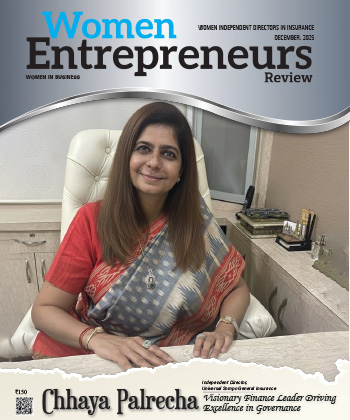
Capacity Building to Cultural Transformation: Future-Proofing Talent Through Learning Innovation
By: Sushma Bendore, Senior Vice President-Human Resources, Motilal Oswal Financial Services
Sushma Bendore serves as the Senior Vice president- Human Resource at Motilal Oswal Financial Services Ltd (MOFSL), where she leads enterprise-wide learning initiatives with strategic vision and impact. With over 21 years of expertise in Capability Development, she has previously held leadership roles at Cipla, Jio, and Aditya Birla Group.
She holds a pivotal role overseeing the Learning Function across all divisions within the MOFSL. A member of the British Psychological Society, Sushma brings both depth and breadth to the evolving HR landscape at MOFSL, staying committed as a lifelong learner.
During a conversation with Women Entrepreneur Review, Sushma highlights L&D’s crucial role in leadership development and more. She highlights that creating a future-proof workforce means investing in continuous learning and empowering talent to adapt, innovate, and lead in the AI era. In her view, both men and women must be empowered with the capabilities and presence to lead with confidence in an evolving business landscape.
Outlining the organization’s shift to digital-first learning, she underscores the imperative need to draw a balance for capacity building with long-term leadership readiness. Recognizing the dynamics of male-dominated sectors, Sushma asserts that women leaders must pair resilience with influence, whereas strategic delegation and commercial savvy acumen are essential for impact at scale.
How is the rise of AI and digitalization reshaping L&D strategies? Are there new approaches that are proving effective, especially in empowering women to thrive in these changing dynamics?
As AI transforms the financial sector, its gender-neutral nature offers both opportunities and uncertainties. While the full impact, particularly in areas like advisory and group services, is still unfolding, one thing is clear that organizations must continuously evolve or risk losing market share. The focus now is on ensuring that learning and development can future-proof talent for the AI era.
To future-proof our workforce in a rapidly evolving tech landscape, we must equip them with AI-specific learning pathways. Organizations are actively seeking ways to embed AI into talent development.
Teams are expected to innovate with AI, driving the need for structured, AI-focused upskilling. It requires the organizations to empower their talent to stay relevant and perform more efficiently.
Proactive learning must take priority in today’s evolving landscape. Once opportunities pass, re-engaging employees in learning becomes increasingly difficult. It is essential for both men and women to commit to continuous upskilling now to remain competitive and prepared for future roles.
As a Chief Learning Officer, how do you design learning initiatives that specifically address the unique challenges women face in the finance industry?
Driving gender balance requires industry-specific insights and intentional leadership planning. With women making 23 percent of our workforce, we are working to address attrition at higher levels by building a robust succession pipeline that ensures women are considered for all critical roles.
In line with our commitment to gender diversity at all levels, we are rolling out a dual-track initiate compromising a Women Leadership Programme and a Women Mentoring Programme. The leadership programme aims at mid-level and emerging senior leaders will span approximately 12 months and incorporate focused classroom training, internal mentoring, and development sessions designed to equip women with the capabilities needed to lead transformational change.
Our leadership development strategy is built on a three-tiered framework: Personal Leadership focuses on self-awareness and individual effectiveness; Relational Leadership builds team management and inclusive collaboration skills, and Enterprises Leadership sharpens strategic thinking and innovation. Each layer is supported by tools like psychometric assessments and curated development journeys.
What’s your perspective on the future of traditional finance learning programs, especially in relation to women’s upskilling and access to leadership development opportunities?
As we design digital-first learning frameworks it is imperative to differentiate between solving today’s skill gaps and preparing for tomorrow’s workforce demands. With traditional competencies losing relevance every few years, as highlighted by the World Economic Forum, forward-looking learning interventions are no longer optional, they are strategic imperatives.
In the visually driven industry like ours, we are designing an Executive Presence program specially for top leadership. Both male and female leaders must be equipped with the skills and awareness needed to refine and project a strong, confident presence. True capability-building is a gradual process. Concepts like financial literacy, behavioural effectives, and leadership coaching need time to resonate and become actionable.
A hybrid model that combines digital-first innovation with the depth of the traditional learning pathways ensures a more sustainable, impactful learning curve. While we acknowledge the role of digital tools, we strategically position them as a secondary option. Our approach remains flexible, but always learner-centric.
In the context of a diverse workforce, how do you foster an inclusive learning culture within your organization that encourages women at all levels to step into leadership roles and not just participate in but also drive major decision-making processes?
Leadership assessment should occur quarterly. It is vital to recognize that while women leaders exist across all organization, their representation declines at senior levels, ensuring equity through proactive identification and development efforts.
As HR leaders, we must constantly ask ourselves: are we aware of these biases, and are we actively countering them during evaluations? When selecting participants for leadership or upskilling programs, are we ensuring balanced gender representation, or defaulting to a homogenous group.
A lack of women in key programs points to gaps in progression, often tied to career breaks. It is not just a learning issue- it is about building inclusive structures that enable sustained growth. Supporting return-to-work mothers goes beyond policy.
Are we enabling them-especially in the crucial first year, with the right team dynamics, empathy, and flexibility to truly thrive? It is critical for HR leaders to lead with awareness and discipline, ensuring fairness and equity in leadership assessments.
Which learning competencies will be crucial for women leaders in the finance industry to thrive in the next 5-10 years? How are you proactively preparing women for leadership roles in the face of evolving market trends?
With the pace of change accelerating across industries, it is increasingly clear that competencies are not static. Every few years, shifts in strategic direction require leaders to re-skill and realign. Yet, the foundational qualities remain rooted in self. For women leaders navigating male-dominated boardrooms, it is not just about possessing resilience, it is about learning to articulate those traits in impactful, influential ways that command attention and drive results.
Emotional intelligence plays a critical role in leadership, especially for women, who naturally communicate with passion and authenticity. The key lies in balancing heartfelt communication with emotional regulation that can be managed through coaching, mentoring, and self-awareness.
The nurturing mindset, while powerful, must be applied selectively in leadership. While women often bring this quality into the workplace, it may lead to over-involvement. Strategic delegation is essential to avoid dependency and promote team autonomy. Effective delegation empowers women leaders to scale their impact within corporate hierarchy. Business acumen must sit at the core of every leader’s toolkit to ensure credibility and informed decision-making.
Most Viewed
- 1 Women's Health Startup HerMD Closing Doors Amid Industry Challenges
- 2 5 Famous Women in Indian Armed Forces
- 3 Saudi Women No longer Require Male Permission for Clothing Choices, says Prince MbS
- 4 Kolkata Medtech Startup Innovodigm Raises Rs 5.5 Crore Seed Funding Led by IAN Group
- 5 Yamunanagar's Kashish Kalra Honoured after Securing 111th Rank in UPSC Civil Services Exam
- 6 Madurai Appoints Its First Woman Corporation Head
- 7 IAS Vijayalakshmi Bidari Appointed as the new Nagpur Divisional Commissioner
- 8 American Entrepreneur Lucy Guo Overtakes T Swift to become Youngest Female Billionaire
- 9 ICC Women's World Cup 2025 Trophy Showcased at Indore's Holkar Stadium
- 10 Aparna Saxena's Beauty Venture AntiNorm Launches in India
- 11 Vidya Nataraj Co-Founded BlueStone Jewellery & Lifestyle files IPO
- 12 5 Women Freedom Fighters of India
- 13 Dr. G Krishnapriya appointed as CEO for Trichy
- 14 M3M & Sirona Partner to Introduce Menstrual Hygiene Vending Machines in 15 Locations
- 15 Punjab Govt launches SHE Cohort 3.0 Supporting Tech-led Women Startups
- 16 Indian origin Lawyer, Sweena Pannu appointed as the US New Superior Court Judge
- 17 The Aurora Tech Award recognizes 4 Indian Women-led Startups
- 18 Kerala's Republic Day parade featured an all-female tableau
- 19 Manisha Kabbur Becomes Karnataka's First Woman International Karate Coach
- 20 Director K. S. Ravikumar's Daughter Maalica Ravikumar Launches Life Coaching Company 'Evergrowth Academy' for Women
- 21 Leezu's Raises Pre-Seed Funding to Accelerate Growth in Sexual Wellness Industry
- 22 Sattu: Super-easy summer drink for PCOS gut healing
- 23 Swathi Nelabhatla creates Sitha App, India's First Women-Exclusive Gig Platform
- 24 7 Timeless Female Kathak Dancers & their Iconic Legacies
- 25 Meet 7 Iconic Women Architects of Modern India & their Most Impactful Work
- 26 This Woman-led Insuretech Startup is Helping Bridge the Education Financing Gap in India
- 27 Women Leaders Share Lessons Learnt from India Women's WC Win
- 28 5 Enterprising Women Founders Powering Singapore's Tech & Innovation Landscape
- 29 4 Women. 4 Stories. One Vision for Smarter, Stronger Healthcare
- 30 Global Gender Gap Narrows to 68.8%, But Full Equality 123 Years Away: WEF Report 2025
- 31 Changemakers: 7 Women Entrepreneurs Taking the Make in India Movement Forward
- 32 Meet Lucy Guo, The Youngest Self-Made Female Billionaire Disrupting Tech
- 33 How Women are Driving India's Festive Online Shopping Surge






